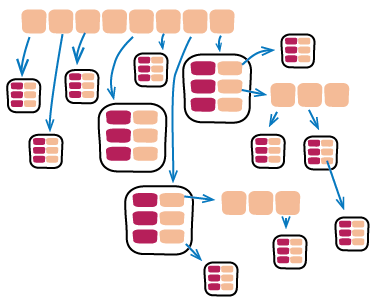List And Hash
3 December 2015
It's now common in many programming environments to represent data structures as a composite of lists and hashmaps. Most major languages now provide standard versions of these data structures, together with a rich range of operations, in particular Collection Pipelines, to manipulate them. These data structures are very flexible, allowing us to represent most forms of hierarchy in a manner that's easy to process and manipulate. 1
1: I find it awkward that there's no generally accepted, cross-language term for this kind of data structure. I could do with such a term, hence my desire to make a Neologism

The essence of this data structure is that there are (usually) two composite data types:
- Hashmaps are a key-value data structure, which may be called associative arrays, hashtables, maps, or dictionaries.
- Lists are simple sequences. They're not quite the same as traditional arrays as they dynamically resize as you add or remove elements (some languages do call them arrays, however). They can be indexed by integer keys.
The leaves of the tree can be any other element, commonly the basic primitives in the language (such as integers and strings), but also any other structure that isn't treatable as a list or hash.
In most cases there are separate data types for the list and hash, since their access operations differ. However, as any lisper can tell you, it's easy to represent a hash as a list of key-value pairs. Similarly you can treat a hash with numeric indexes as a list (which is what Lua's tables do).
A list 'n' hash structure is by default schemaless, the lists can contain disparate elements and the hashes any combination of keys. This allows the data structure to be very flexible, but we must remember that we nearly always have an implicit schema when we manipulate a schemaless data structure, in that we expect certain data to be represented with certain keys.
A strength of the list and hash structure is that you can manipulate it with generic operations which know nothing of the actual keys present. These operations can then be parameterized with the keys that you wish to manipulate. The generic operations, usually arranged into a collection pipeline, provide a lot of navigation features to allow you to pluck what you need from the data structure without having to manipulate the individual pieces.
Although the usual way is to use flexible hashes for records, you can take a structure that uses defined record structures (or objects) and manipulate it in the same way as a hash if those record structures provide reflective operations. While such a structure will restrict what you can put in it (which is often a Good Thing), using generic operations to manipulate it can be very useful. But this does require the language environment to provide the mechanism to query records as if they are hashes.
List and hash structures can easily be serialized, commonly into a textual form. JSON is a particularly effective form of serialization for such a data structure, and is my default choice for this. Often XML is used to serialize list 'n' hash structures, it does a serviceable job, but is verbose and the distinction between attributes and elements makes no sense for these structures (although it makes plenty of sense for marking up text).
Despite the fact that list 'n' hashes are very common, there are times I wish I was using a thoughtful tree representation. Such a model can provide richer navigation operations. When working with the serialized XML structures in Nokogiri, I find it handy to be able to use XPath or CSS selectors to navigate the data structure. Some kind of common path specification such as these is handy for larger documents. Another issue is that it can be more awkward than it should to find the parent or ancestors of a given node in the tree. The presence of rich lists and hashes as standard equipment in modern languages has been one of the definite improvements in my programming life since I started programming in Fortran IV, but there's no need to stop there.
Acknowledgements
David Johnston, Marzieh Morovatpasand, Peter Gillard-Moss, Philip Duldig, Rebecca Parsons, Ryan Murray, and Steven Lowe discussed this post on our internal mailing list.Notes
1: I find it awkward that there's no generally accepted, cross-language term for this kind of data structure. I could do with such a term, hence my desire to make a Neologism

